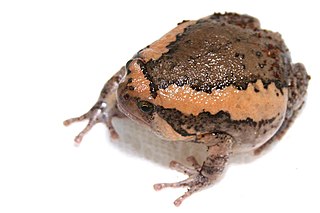
Eastern spadefoot toads comprise a genus of the family Megophryidae in the order Anura, and are found in southern China, northeast India, southeast Asia, and islands of the Sunda Shelf as well as the Philippines. They are characterized by a stocky body with slender, short hindlimbs. In identifying species, iris colour is a valuable diagnostic morphological characteristic ; the iris has uniform colour in some species, whereas in other species the upper half is coloured and the lower half is dark.

Polypedates is a genus of frogs in the family Rhacophoridae, the shrub frogs and Paleotropic tree frogs. They belong to subfamily Rhacophorinae. Members of this genus are collectively known as whipping frogs. They occur in eastern and southern Asia.

Fejervarya is a genus of frogs in the family Dicroglossidae found in Asia. First proposed in 1915 by István József Bolkay, a Hungarian naturalist, the genus did not see widespread adoption at first. As late as the 1990s it was generally included in Rana, but more recent studies have confirmed its distinctness.

Limnonectes is a genus of fork-tongued frogs of about 75 known species, but new ones are still being described occasionally. They are collectively known as fanged frogs because they tend to have unusually large teeth, which are small or absent in other frogs.

Kaloula is a genus of microhylid frogs found in southern and eastern Asia. They are sometimes known as the Asian narrowmouth toads.

Kuhl's creek frog or large-headed frog is a species of frog in the family Dicroglossidae.
Djoko Tjahjono Iskandar is an Indonesian herpetologist who studies the amphibians of Southeast Asia and Australasia. He is a professor of biosystematics and ecology at Bandung Institute of Technology in West Java, Indonesia.

Gracixalus is a genus of shrub frogs from south-eastern Asia.
Limnonectes jarujini is a species of frog in the family Dicroglossidae, first described from near Kaeng Krachan Dam, Thailand. It occurs in southwestern and southern, peninsular Thailand, and likely in adjacent southern Myanmar. It has been recorded from Kanchanaburi, Surat Thani, and Nakhon Si Thammarat provinces.

Limnonectes isanensis is a species of fanged frogs in the family Dicroglossidae. It was discovered in Phu Luang Wildlife Sanctuary, Loei Province, Thailand in 2012. It belongs to the Limnonectes kuhlii species complex.
Limnonectes longchuanensis is a species of fanged frogs in the family Dicroglossidae. It is endemic to Yunnan, China and Myanmar.
Limnonectes nguyenorum is a species of fanged frog in the family Dicroglossidae. It is endemic to northern Vietnam and only known from the area of its type locality in Vi Xuyen District, northwestern Ha Giang Province, northern Vietnam. It is part of the Limnonectes kuhlii species complex.
Limnonectes bannaensis is a species of frogs in the family Dicroglossidae. It is found in southern China, Laos, Thailand and Vietnam.
Limnonectes deinodon is a species of fanged frogs in the family Dicroglossidae. It is endemic to peninsular Malaysia and likely also southern Thailand. It was previously confused with Limnonectes laticeps and Limnonectes khasianus.
Limnonectes selatan is a species of fanged frogs in the family Dicroglossidae. It is endemic to peninsular Malaysia, in the states of Pahang and Selangor.
Limnonectes sinuatodorsalis is a species of fanged frog in the family Dicroglossidae. It is endemic to Borneo, where it was found in the border region of East Kalimantan and Sarawak.
Limnonectes utara is a species of fanged frogs in the family Dicroglossidae. It can be found in Malaysia and Thailand.
Limnonectes sisikdagu is a species of fanged frogs in the family Dicroglossidae. It is endemic to West Sumatra, Indonesia, where its holotype was found near Solok. It is part of the Limnonectes kuhlii species complex.
Limnonectes quangninhensis is a species of fanged frog in the family Dicroglossidae. Its type locality is Quảng Sơn Commune, Hải Hà District, Quảng Ninh Province, Vietnam, where it was found in an evergreen forest near Tai Chi Village. It is found in islands of the Gulf of Tonkin, and is also likely found across the border in Fangchenggang, Guangxi, China. It is a sister taxon to Limnonectes fujianensis.
Niane Sivongxay is a zoologist and herpetologist from Laos, who is Director of the South East Asian Ministers of Education Organisation (SEAMEO) Regional Centre for Community Education Development and is Assistant Professor of Biology at the National University of Laos. She specialises in the study of zooplankton, amphibians and reptiles.








